Contemporary Economics: Demand, Supply, and Business Practices
VerifiedAdded on 2023/01/11
|16
|3030
|2
Report
AI Summary
This report, prepared for the BM533 Contemporary Business Economics module, delves into fundamental microeconomic concepts, specifically focusing on the laws of demand and supply. It examines the factors influencing shifts and movements along these curves, using Tesco as a case study to illustrate real-world applications. The report further compares and contrasts economic theories and models of the 20th and 21st centuries, exploring their evolution and relevance to modern business practices. It covers the core principles of microeconomics, analyzing consumer behavior, market dynamics, and how these principles influence business decision-making. The analysis includes the impact of various factors, such as income, price of related products, expectations, population, and trends, on demand and supply. Furthermore, it presents a critical review of how economic theories have evolved, reflecting on the shift from traditional profit-driven models to contemporary approaches that integrate economic theories with business practices for strategic planning and decision-making. The report concludes with a synthesis of the key findings and implications for contemporary business economics.
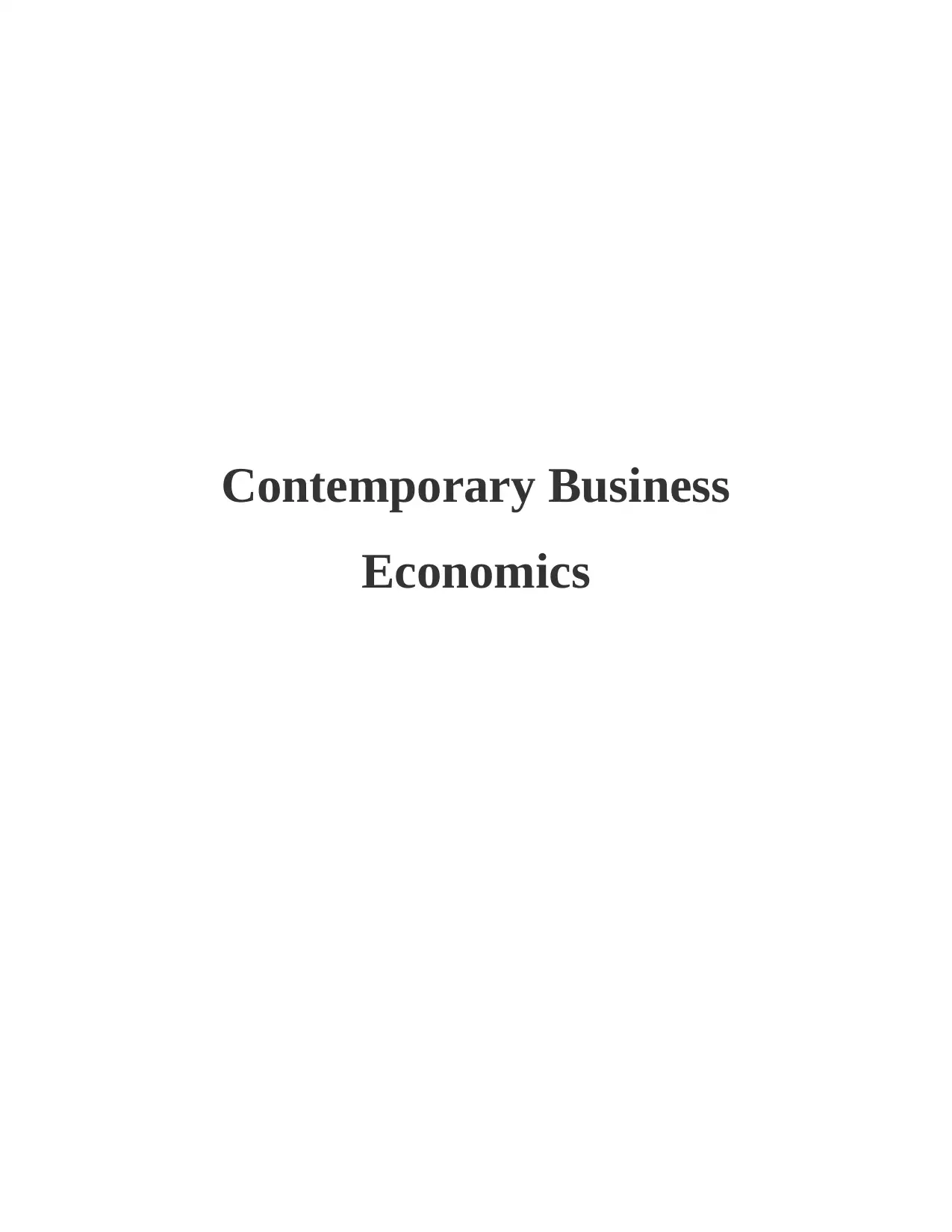
Contemporary Business
Economics
Economics
Paraphrase This Document
Need a fresh take? Get an instant paraphrase of this document with our AI Paraphraser
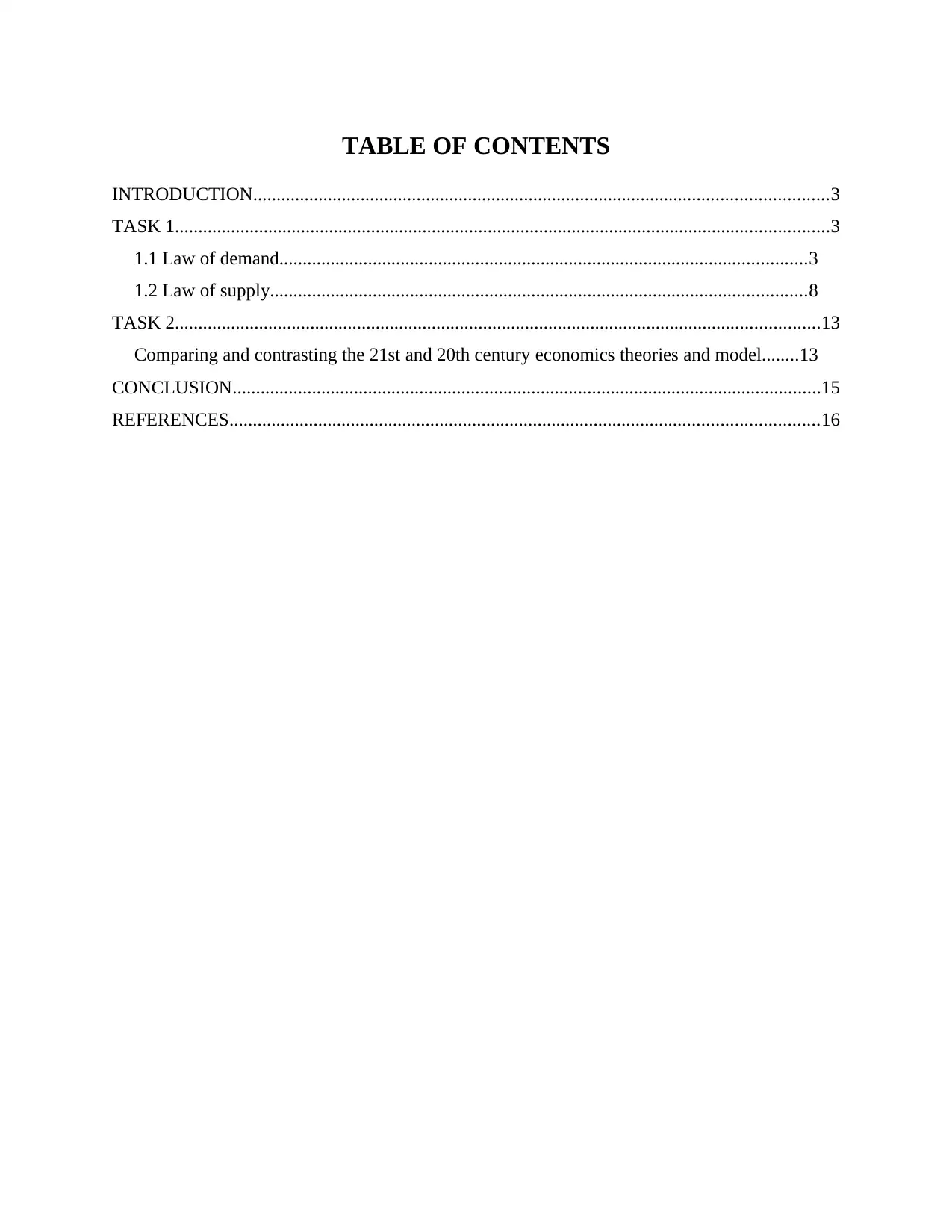
TABLE OF CONTENTS
INTRODUCTION...........................................................................................................................3
TASK 1............................................................................................................................................3
1.1 Law of demand.................................................................................................................3
1.2 Law of supply...................................................................................................................8
TASK 2..........................................................................................................................................13
Comparing and contrasting the 21st and 20th century economics theories and model........13
CONCLUSION..............................................................................................................................15
REFERENCES..............................................................................................................................16
INTRODUCTION...........................................................................................................................3
TASK 1............................................................................................................................................3
1.1 Law of demand.................................................................................................................3
1.2 Law of supply...................................................................................................................8
TASK 2..........................................................................................................................................13
Comparing and contrasting the 21st and 20th century economics theories and model........13
CONCLUSION..............................................................................................................................15
REFERENCES..............................................................................................................................16
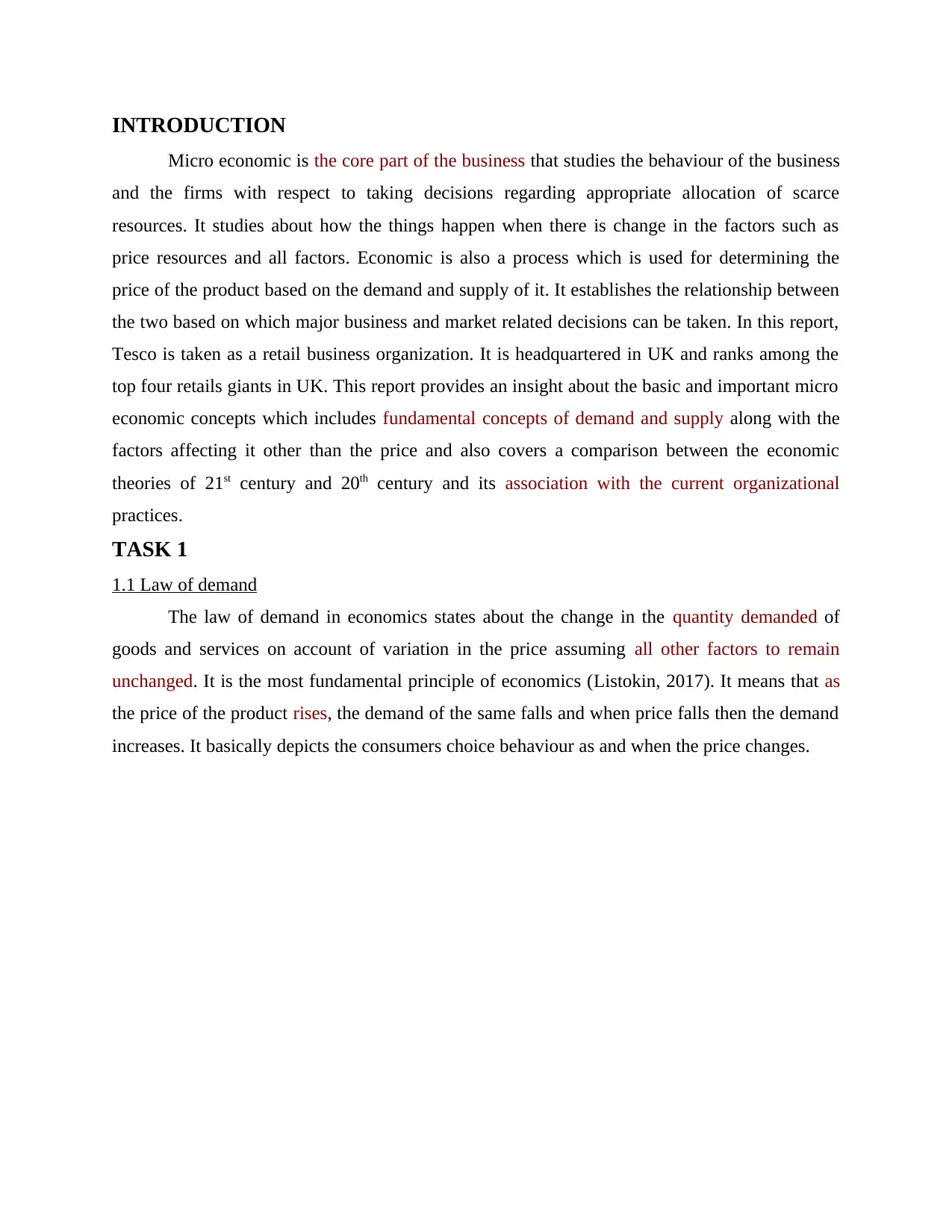
INTRODUCTION
Micro economic is the core part of the business that studies the behaviour of the business
and the firms with respect to taking decisions regarding appropriate allocation of scarce
resources. It studies about how the things happen when there is change in the factors such as
price resources and all factors. Economic is also a process which is used for determining the
price of the product based on the demand and supply of it. It establishes the relationship between
the two based on which major business and market related decisions can be taken. In this report,
Tesco is taken as a retail business organization. It is headquartered in UK and ranks among the
top four retails giants in UK. This report provides an insight about the basic and important micro
economic concepts which includes fundamental concepts of demand and supply along with the
factors affecting it other than the price and also covers a comparison between the economic
theories of 21st century and 20th century and its association with the current organizational
practices.
TASK 1
1.1 Law of demand
The law of demand in economics states about the change in the quantity demanded of
goods and services on account of variation in the price assuming all other factors to remain
unchanged. It is the most fundamental principle of economics (Listokin, 2017). It means that as
the price of the product rises, the demand of the same falls and when price falls then the demand
increases. It basically depicts the consumers choice behaviour as and when the price changes.
Micro economic is the core part of the business that studies the behaviour of the business
and the firms with respect to taking decisions regarding appropriate allocation of scarce
resources. It studies about how the things happen when there is change in the factors such as
price resources and all factors. Economic is also a process which is used for determining the
price of the product based on the demand and supply of it. It establishes the relationship between
the two based on which major business and market related decisions can be taken. In this report,
Tesco is taken as a retail business organization. It is headquartered in UK and ranks among the
top four retails giants in UK. This report provides an insight about the basic and important micro
economic concepts which includes fundamental concepts of demand and supply along with the
factors affecting it other than the price and also covers a comparison between the economic
theories of 21st century and 20th century and its association with the current organizational
practices.
TASK 1
1.1 Law of demand
The law of demand in economics states about the change in the quantity demanded of
goods and services on account of variation in the price assuming all other factors to remain
unchanged. It is the most fundamental principle of economics (Listokin, 2017). It means that as
the price of the product rises, the demand of the same falls and when price falls then the demand
increases. It basically depicts the consumers choice behaviour as and when the price changes.
⊘ This is a preview!⊘
Do you want full access?
Subscribe today to unlock all pages.

Trusted by 1+ million students worldwide
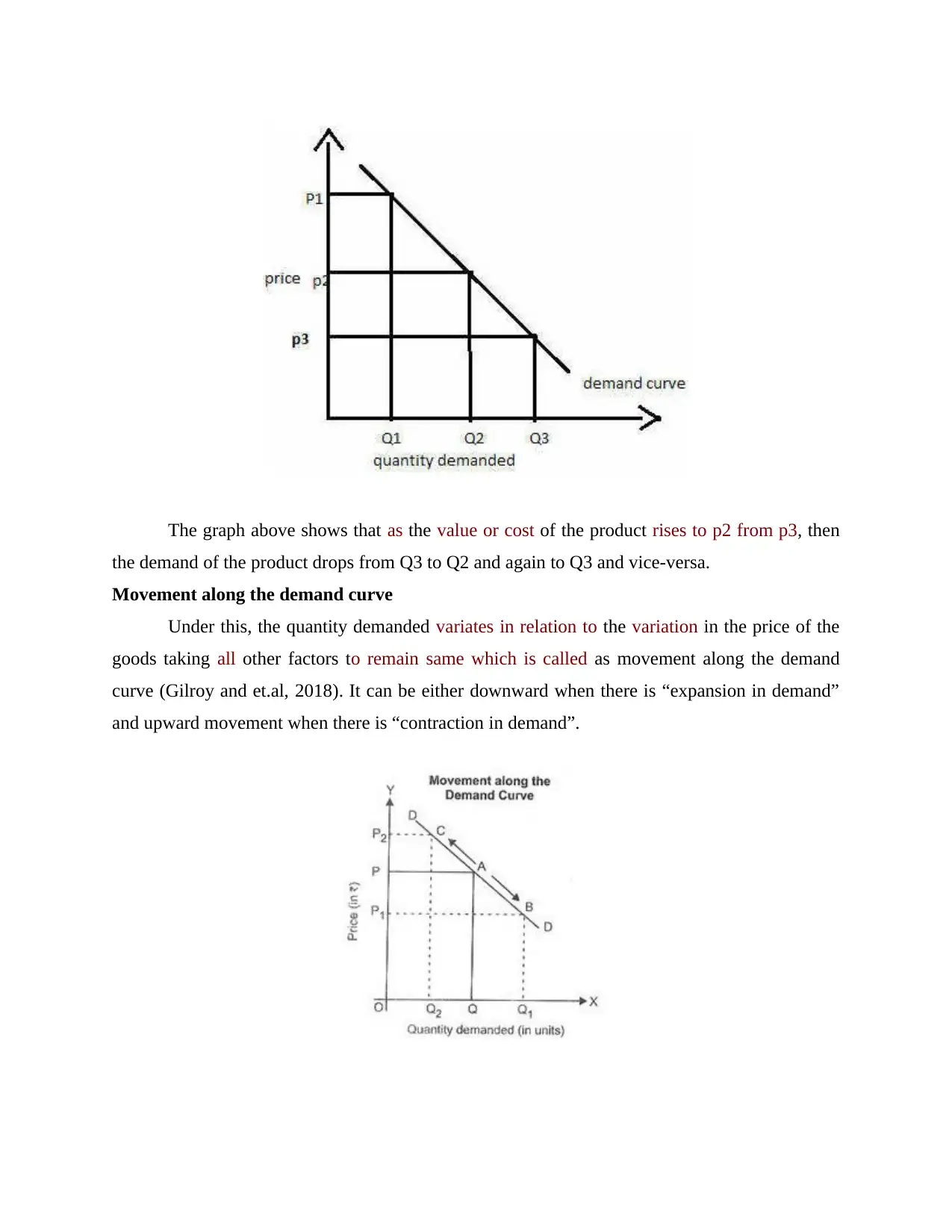
The graph above shows that as the value or cost of the product rises to p2 from p3, then
the demand of the product drops from Q3 to Q2 and again to Q3 and vice-versa.
Movement along the demand curve
Under this, the quantity demanded variates in relation to the variation in the price of the
goods taking all other factors to remain same which is called as movement along the demand
curve (Gilroy and et.al, 2018). It can be either downward when there is “expansion in demand”
and upward movement when there is “contraction in demand”.
the demand of the product drops from Q3 to Q2 and again to Q3 and vice-versa.
Movement along the demand curve
Under this, the quantity demanded variates in relation to the variation in the price of the
goods taking all other factors to remain same which is called as movement along the demand
curve (Gilroy and et.al, 2018). It can be either downward when there is “expansion in demand”
and upward movement when there is “contraction in demand”.
Paraphrase This Document
Need a fresh take? Get an instant paraphrase of this document with our AI Paraphraser
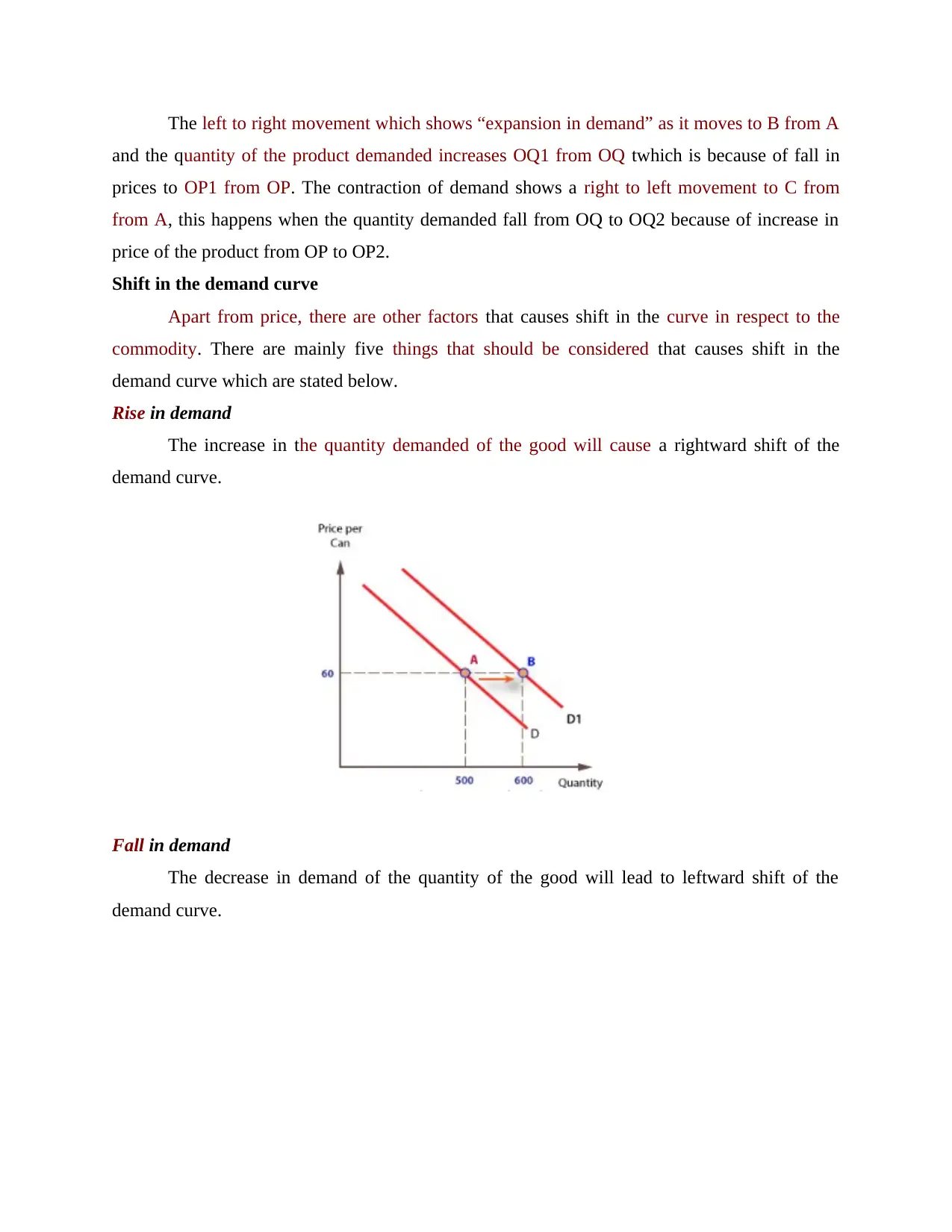
The left to right movement which shows “expansion in demand” as it moves to B from A
and the quantity of the product demanded increases OQ1 from OQ twhich is because of fall in
prices to OP1 from OP. The contraction of demand shows a right to left movement to C from
from A, this happens when the quantity demanded fall from OQ to OQ2 because of increase in
price of the product from OP to OP2.
Shift in the demand curve
Apart from price, there are other factors that causes shift in the curve in respect to the
commodity. There are mainly five things that should be considered that causes shift in the
demand curve which are stated below.
Rise in demand
The increase in the quantity demanded of the good will cause a rightward shift of the
demand curve.
Fall in demand
The decrease in demand of the quantity of the good will lead to leftward shift of the
demand curve.
and the quantity of the product demanded increases OQ1 from OQ twhich is because of fall in
prices to OP1 from OP. The contraction of demand shows a right to left movement to C from
from A, this happens when the quantity demanded fall from OQ to OQ2 because of increase in
price of the product from OP to OP2.
Shift in the demand curve
Apart from price, there are other factors that causes shift in the curve in respect to the
commodity. There are mainly five things that should be considered that causes shift in the
demand curve which are stated below.
Rise in demand
The increase in the quantity demanded of the good will cause a rightward shift of the
demand curve.
Fall in demand
The decrease in demand of the quantity of the good will lead to leftward shift of the
demand curve.
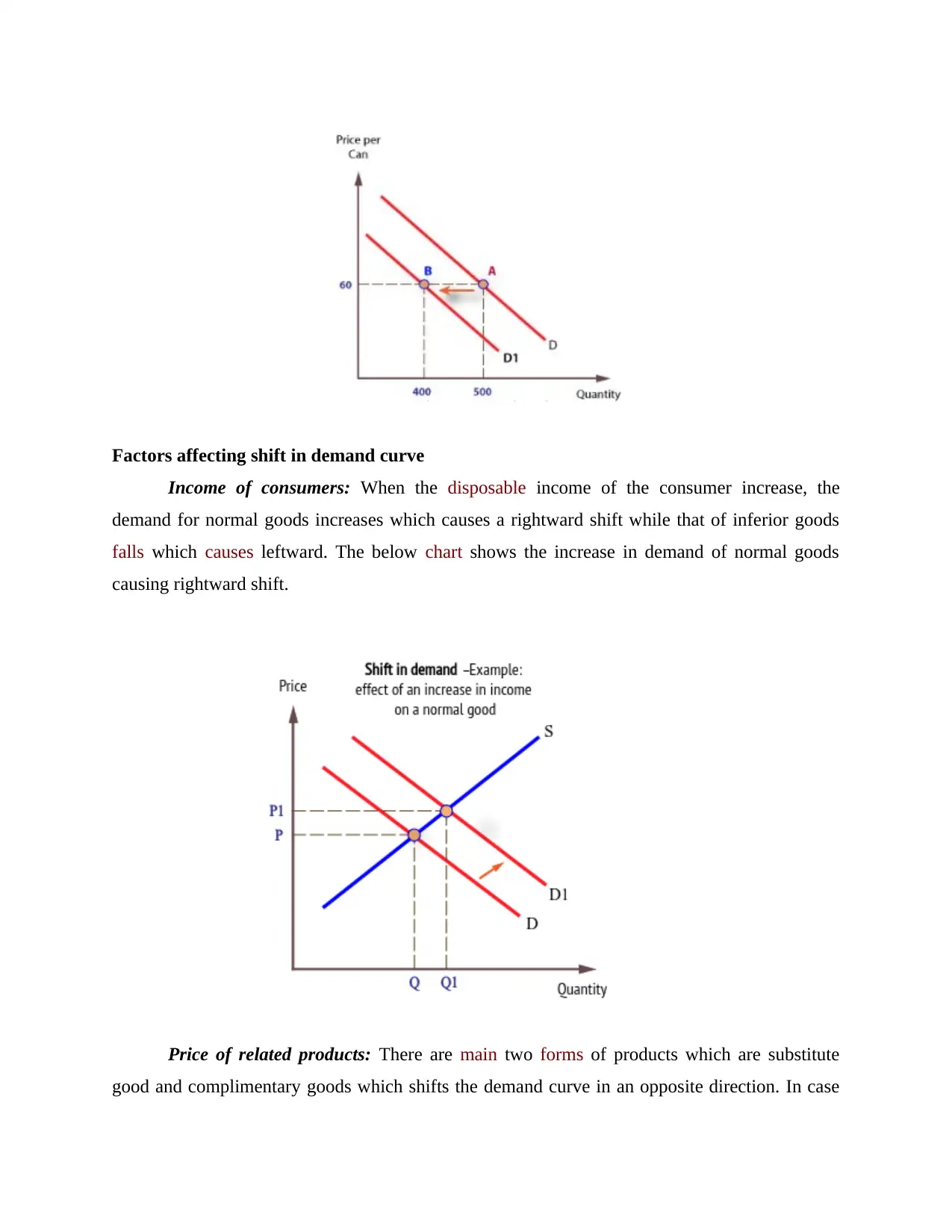
Factors affecting shift in demand curve
Income of consumers: When the disposable income of the consumer increase, the
demand for normal goods increases which causes a rightward shift while that of inferior goods
falls which causes leftward. The below chart shows the increase in demand of normal goods
causing rightward shift.
Price of related products: There are main two forms of products which are substitute
good and complimentary goods which shifts the demand curve in an opposite direction. In case
Income of consumers: When the disposable income of the consumer increase, the
demand for normal goods increases which causes a rightward shift while that of inferior goods
falls which causes leftward. The below chart shows the increase in demand of normal goods
causing rightward shift.
Price of related products: There are main two forms of products which are substitute
good and complimentary goods which shifts the demand curve in an opposite direction. In case
⊘ This is a preview!⊘
Do you want full access?
Subscribe today to unlock all pages.

Trusted by 1+ million students worldwide
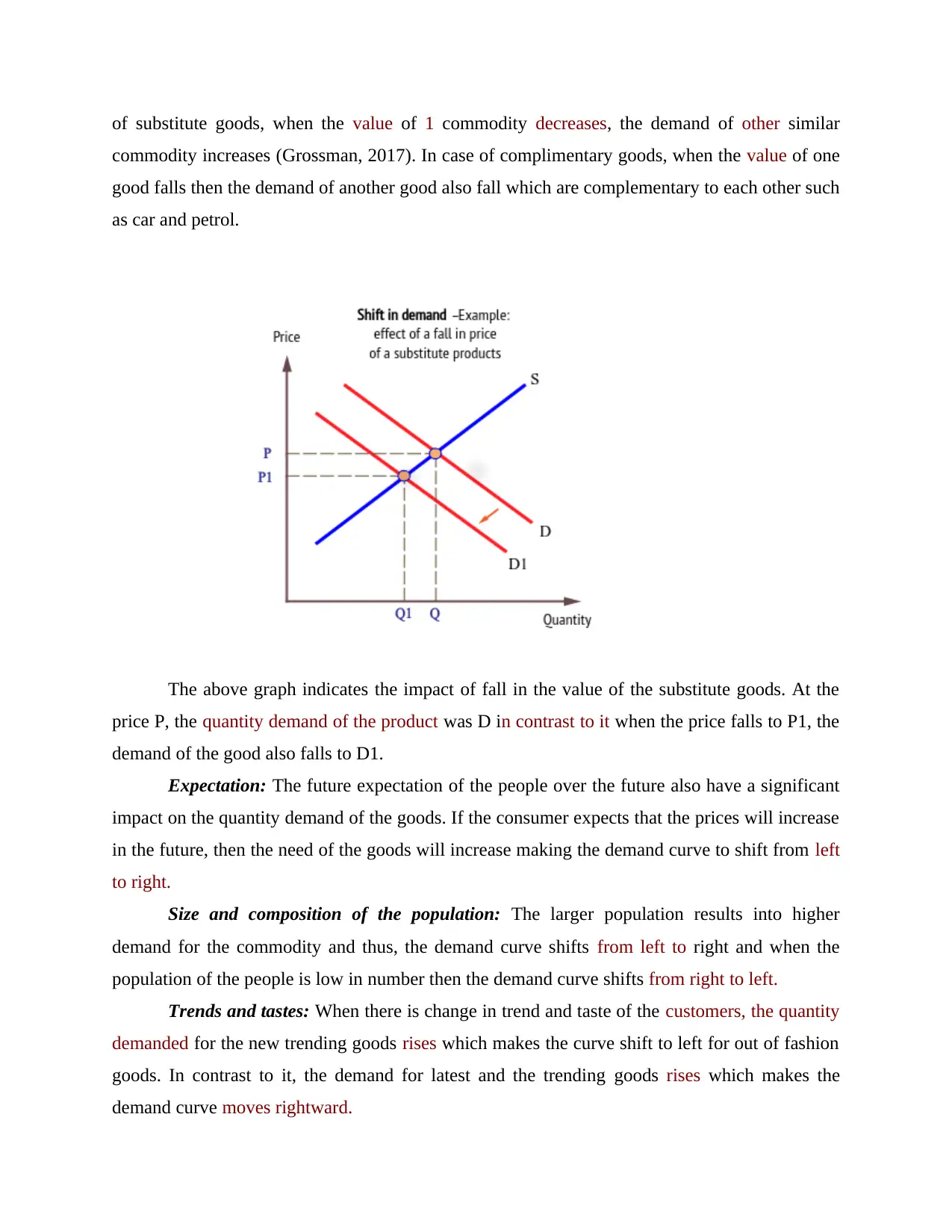
of substitute goods, when the value of 1 commodity decreases, the demand of other similar
commodity increases (Grossman, 2017). In case of complimentary goods, when the value of one
good falls then the demand of another good also fall which are complementary to each other such
as car and petrol.
The above graph indicates the impact of fall in the value of the substitute goods. At the
price P, the quantity demand of the product was D in contrast to it when the price falls to P1, the
demand of the good also falls to D1.
Expectation: The future expectation of the people over the future also have a significant
impact on the quantity demand of the goods. If the consumer expects that the prices will increase
in the future, then the need of the goods will increase making the demand curve to shift from left
to right.
Size and composition of the population: The larger population results into higher
demand for the commodity and thus, the demand curve shifts from left to right and when the
population of the people is low in number then the demand curve shifts from right to left.
Trends and tastes: When there is change in trend and taste of the customers, the quantity
demanded for the new trending goods rises which makes the curve shift to left for out of fashion
goods. In contrast to it, the demand for latest and the trending goods rises which makes the
demand curve moves rightward.
commodity increases (Grossman, 2017). In case of complimentary goods, when the value of one
good falls then the demand of another good also fall which are complementary to each other such
as car and petrol.
The above graph indicates the impact of fall in the value of the substitute goods. At the
price P, the quantity demand of the product was D in contrast to it when the price falls to P1, the
demand of the good also falls to D1.
Expectation: The future expectation of the people over the future also have a significant
impact on the quantity demand of the goods. If the consumer expects that the prices will increase
in the future, then the need of the goods will increase making the demand curve to shift from left
to right.
Size and composition of the population: The larger population results into higher
demand for the commodity and thus, the demand curve shifts from left to right and when the
population of the people is low in number then the demand curve shifts from right to left.
Trends and tastes: When there is change in trend and taste of the customers, the quantity
demanded for the new trending goods rises which makes the curve shift to left for out of fashion
goods. In contrast to it, the demand for latest and the trending goods rises which makes the
demand curve moves rightward.
Paraphrase This Document
Need a fresh take? Get an instant paraphrase of this document with our AI Paraphraser
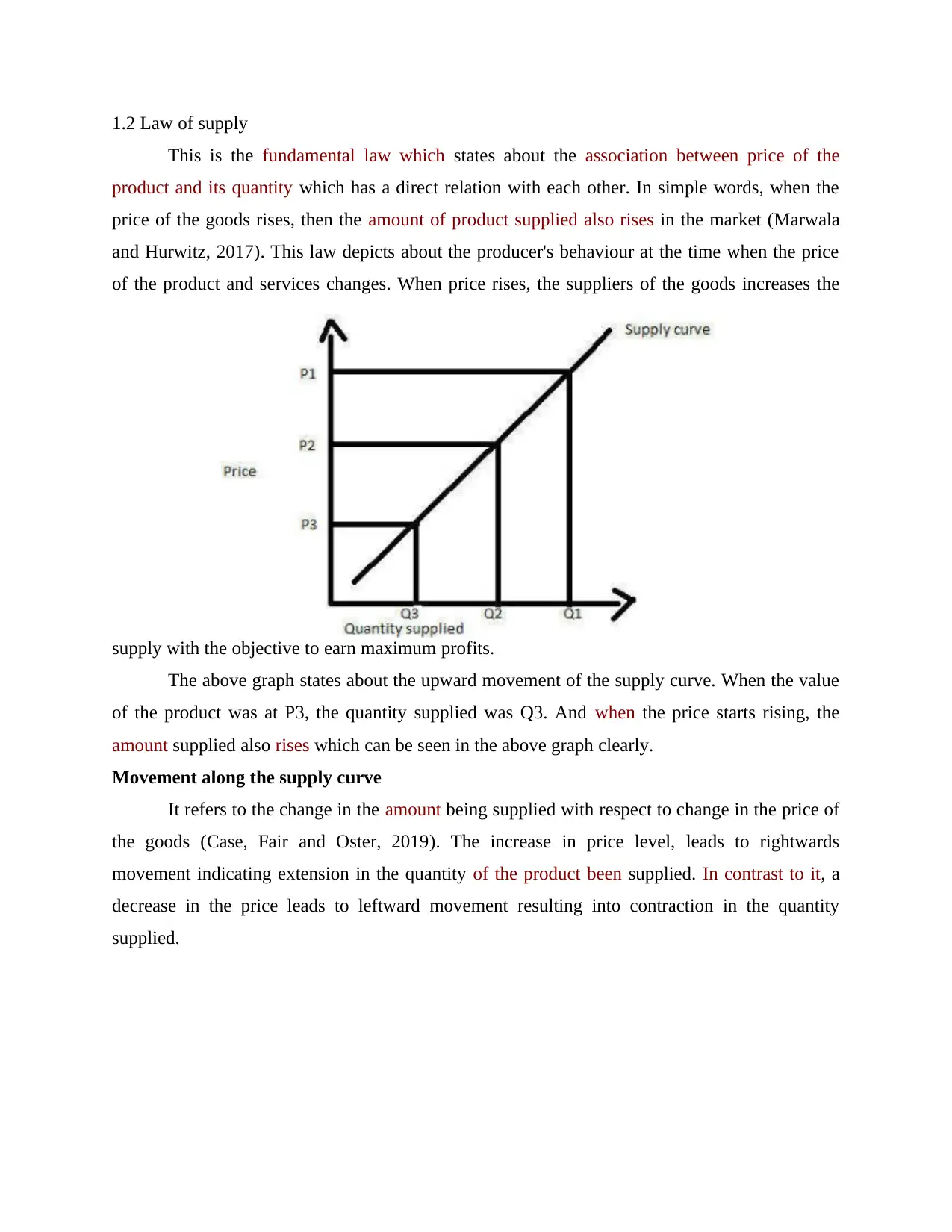
1.2 Law of supply
This is the fundamental law which states about the association between price of the
product and its quantity which has a direct relation with each other. In simple words, when the
price of the goods rises, then the amount of product supplied also rises in the market (Marwala
and Hurwitz, 2017). This law depicts about the producer's behaviour at the time when the price
of the product and services changes. When price rises, the suppliers of the goods increases the
supply with the objective to earn maximum profits.
The above graph states about the upward movement of the supply curve. When the value
of the product was at P3, the quantity supplied was Q3. And when the price starts rising, the
amount supplied also rises which can be seen in the above graph clearly.
Movement along the supply curve
It refers to the change in the amount being supplied with respect to change in the price of
the goods (Case, Fair and Oster, 2019). The increase in price level, leads to rightwards
movement indicating extension in the quantity of the product been supplied. In contrast to it, a
decrease in the price leads to leftward movement resulting into contraction in the quantity
supplied.
This is the fundamental law which states about the association between price of the
product and its quantity which has a direct relation with each other. In simple words, when the
price of the goods rises, then the amount of product supplied also rises in the market (Marwala
and Hurwitz, 2017). This law depicts about the producer's behaviour at the time when the price
of the product and services changes. When price rises, the suppliers of the goods increases the
supply with the objective to earn maximum profits.
The above graph states about the upward movement of the supply curve. When the value
of the product was at P3, the quantity supplied was Q3. And when the price starts rising, the
amount supplied also rises which can be seen in the above graph clearly.
Movement along the supply curve
It refers to the change in the amount being supplied with respect to change in the price of
the goods (Case, Fair and Oster, 2019). The increase in price level, leads to rightwards
movement indicating extension in the quantity of the product been supplied. In contrast to it, a
decrease in the price leads to leftward movement resulting into contraction in the quantity
supplied.
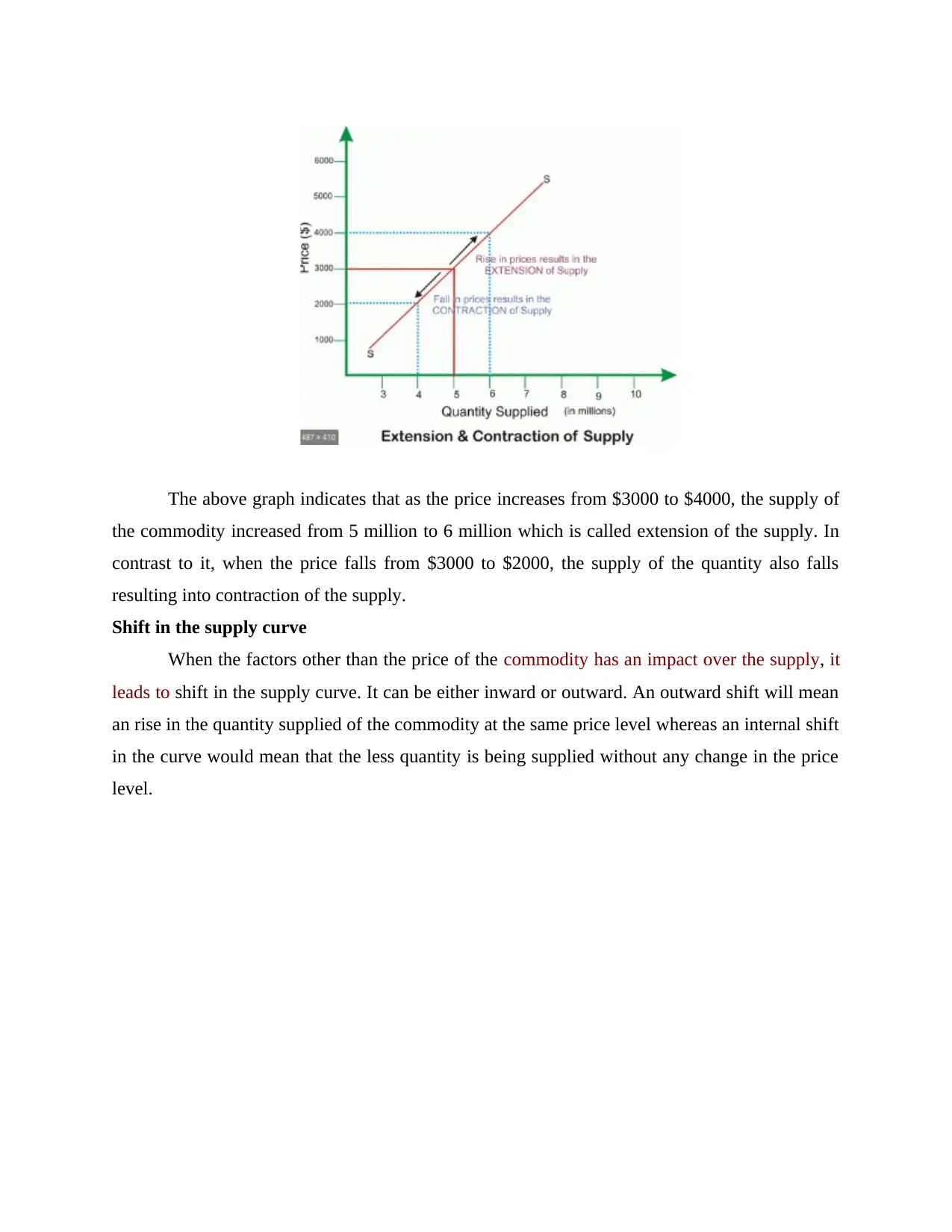
The above graph indicates that as the price increases from $3000 to $4000, the supply of
the commodity increased from 5 million to 6 million which is called extension of the supply. In
contrast to it, when the price falls from $3000 to $2000, the supply of the quantity also falls
resulting into contraction of the supply.
Shift in the supply curve
When the factors other than the price of the commodity has an impact over the supply, it
leads to shift in the supply curve. It can be either inward or outward. An outward shift will mean
an rise in the quantity supplied of the commodity at the same price level whereas an internal shift
in the curve would mean that the less quantity is being supplied without any change in the price
level.
the commodity increased from 5 million to 6 million which is called extension of the supply. In
contrast to it, when the price falls from $3000 to $2000, the supply of the quantity also falls
resulting into contraction of the supply.
Shift in the supply curve
When the factors other than the price of the commodity has an impact over the supply, it
leads to shift in the supply curve. It can be either inward or outward. An outward shift will mean
an rise in the quantity supplied of the commodity at the same price level whereas an internal shift
in the curve would mean that the less quantity is being supplied without any change in the price
level.
⊘ This is a preview!⊘
Do you want full access?
Subscribe today to unlock all pages.

Trusted by 1+ million students worldwide
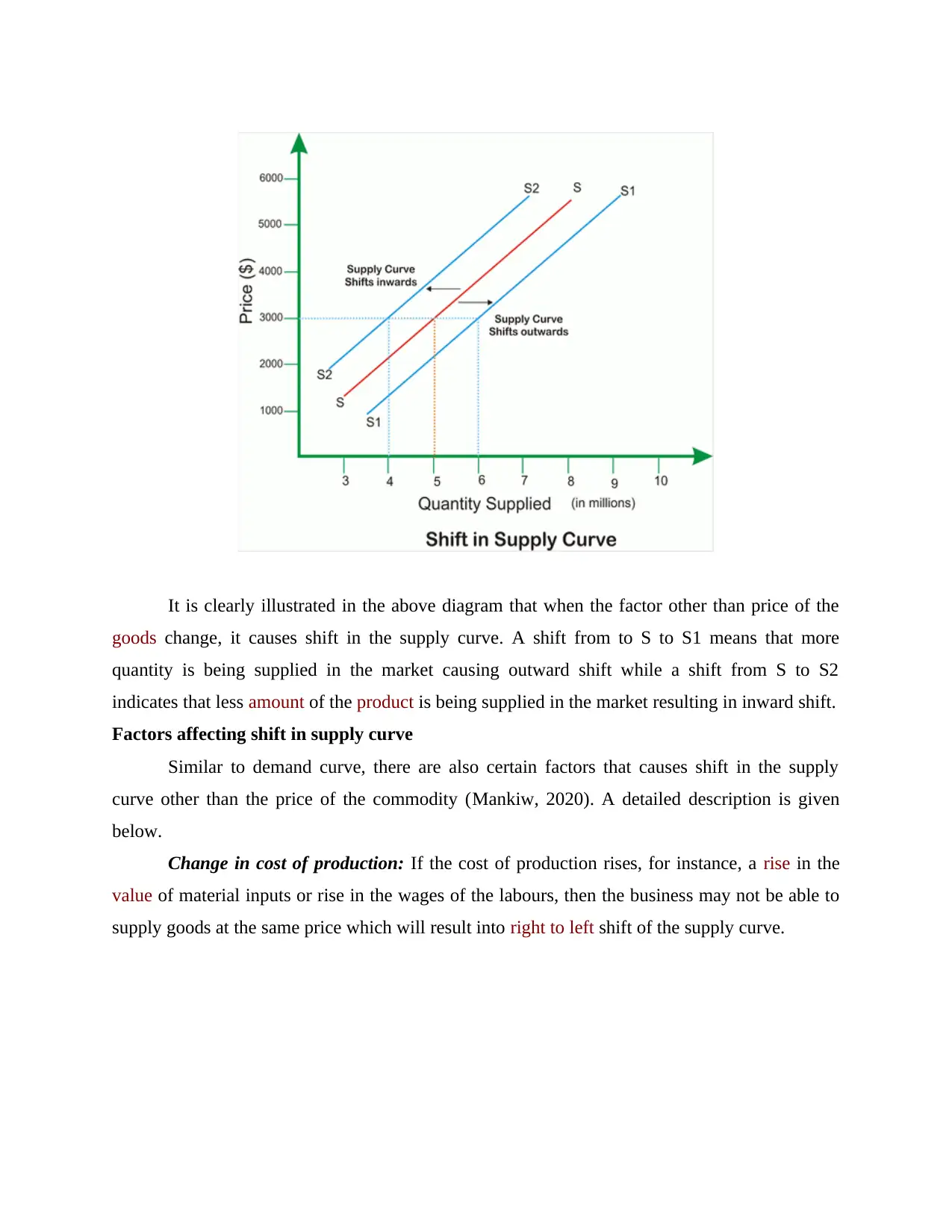
It is clearly illustrated in the above diagram that when the factor other than price of the
goods change, it causes shift in the supply curve. A shift from to S to S1 means that more
quantity is being supplied in the market causing outward shift while a shift from S to S2
indicates that less amount of the product is being supplied in the market resulting in inward shift.
Factors affecting shift in supply curve
Similar to demand curve, there are also certain factors that causes shift in the supply
curve other than the price of the commodity (Mankiw, 2020). A detailed description is given
below.
Change in cost of production: If the cost of production rises, for instance, a rise in the
value of material inputs or rise in the wages of the labours, then the business may not be able to
supply goods at the same price which will result into right to left shift of the supply curve.
goods change, it causes shift in the supply curve. A shift from to S to S1 means that more
quantity is being supplied in the market causing outward shift while a shift from S to S2
indicates that less amount of the product is being supplied in the market resulting in inward shift.
Factors affecting shift in supply curve
Similar to demand curve, there are also certain factors that causes shift in the supply
curve other than the price of the commodity (Mankiw, 2020). A detailed description is given
below.
Change in cost of production: If the cost of production rises, for instance, a rise in the
value of material inputs or rise in the wages of the labours, then the business may not be able to
supply goods at the same price which will result into right to left shift of the supply curve.
Paraphrase This Document
Need a fresh take? Get an instant paraphrase of this document with our AI Paraphraser
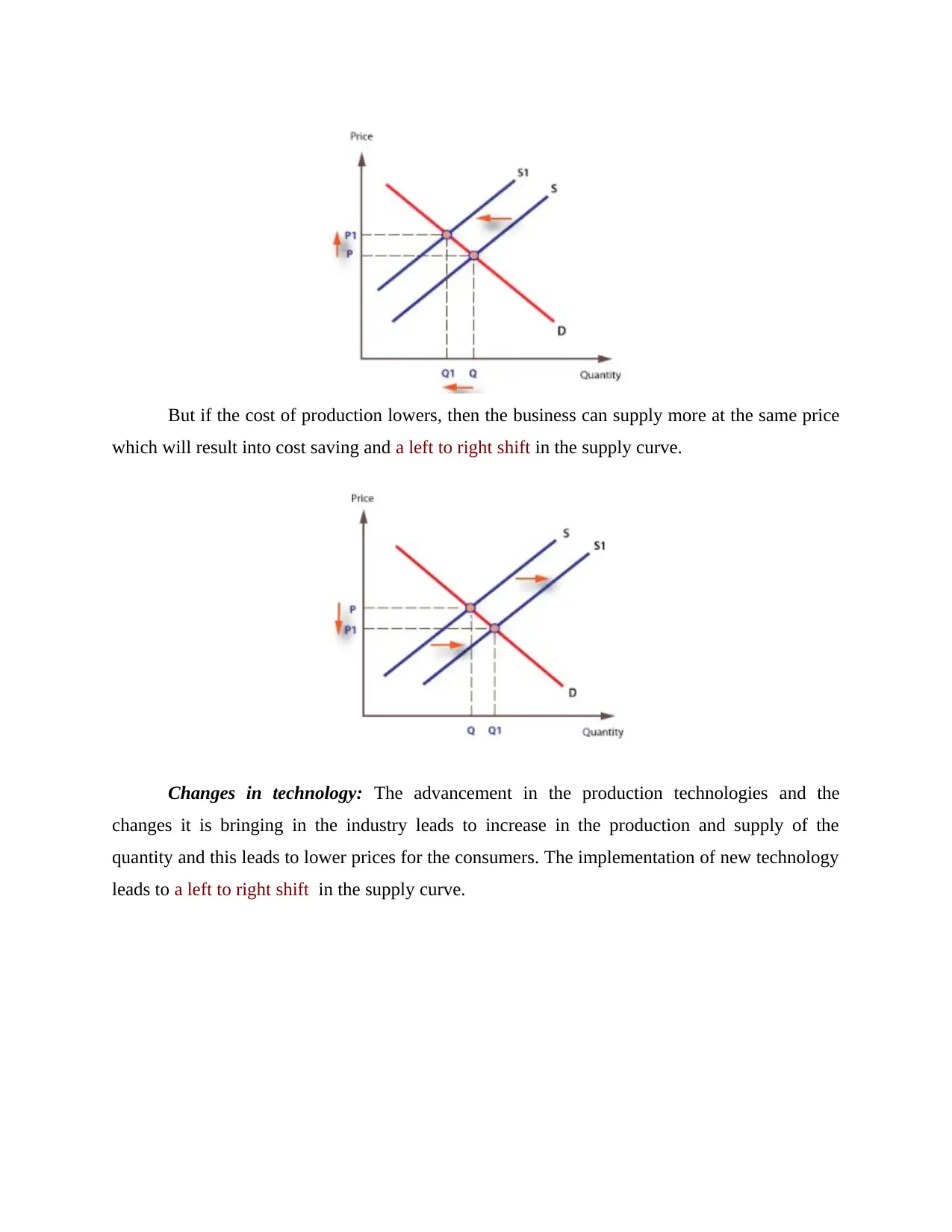
But if the cost of production lowers, then the business can supply more at the same price
which will result into cost saving and a left to right shift in the supply curve.
Changes in technology: The advancement in the production technologies and the
changes it is bringing in the industry leads to increase in the production and supply of the
quantity and this leads to lower prices for the consumers. The implementation of new technology
leads to a left to right shift in the supply curve.
which will result into cost saving and a left to right shift in the supply curve.
Changes in technology: The advancement in the production technologies and the
changes it is bringing in the industry leads to increase in the production and supply of the
quantity and this leads to lower prices for the consumers. The implementation of new technology
leads to a left to right shift in the supply curve.
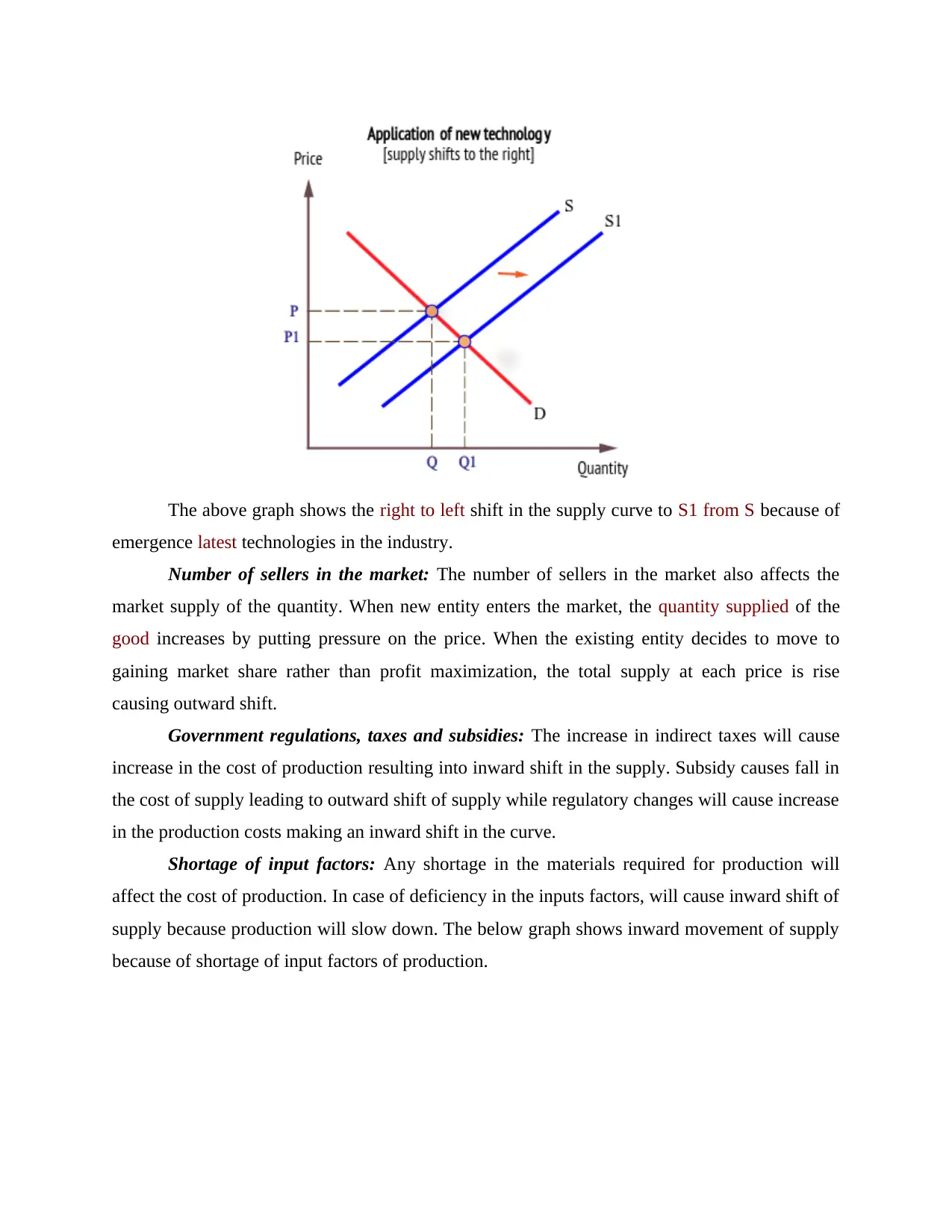
The above graph shows the right to left shift in the supply curve to S1 from S because of
emergence latest technologies in the industry.
Number of sellers in the market: The number of sellers in the market also affects the
market supply of the quantity. When new entity enters the market, the quantity supplied of the
good increases by putting pressure on the price. When the existing entity decides to move to
gaining market share rather than profit maximization, the total supply at each price is rise
causing outward shift.
Government regulations, taxes and subsidies: The increase in indirect taxes will cause
increase in the cost of production resulting into inward shift in the supply. Subsidy causes fall in
the cost of supply leading to outward shift of supply while regulatory changes will cause increase
in the production costs making an inward shift in the curve.
Shortage of input factors: Any shortage in the materials required for production will
affect the cost of production. In case of deficiency in the inputs factors, will cause inward shift of
supply because production will slow down. The below graph shows inward movement of supply
because of shortage of input factors of production.
emergence latest technologies in the industry.
Number of sellers in the market: The number of sellers in the market also affects the
market supply of the quantity. When new entity enters the market, the quantity supplied of the
good increases by putting pressure on the price. When the existing entity decides to move to
gaining market share rather than profit maximization, the total supply at each price is rise
causing outward shift.
Government regulations, taxes and subsidies: The increase in indirect taxes will cause
increase in the cost of production resulting into inward shift in the supply. Subsidy causes fall in
the cost of supply leading to outward shift of supply while regulatory changes will cause increase
in the production costs making an inward shift in the curve.
Shortage of input factors: Any shortage in the materials required for production will
affect the cost of production. In case of deficiency in the inputs factors, will cause inward shift of
supply because production will slow down. The below graph shows inward movement of supply
because of shortage of input factors of production.
⊘ This is a preview!⊘
Do you want full access?
Subscribe today to unlock all pages.

Trusted by 1+ million students worldwide
1 out of 16
Related Documents
Your All-in-One AI-Powered Toolkit for Academic Success.
+13062052269
info@desklib.com
Available 24*7 on WhatsApp / Email
![[object Object]](/_next/static/media/star-bottom.7253800d.svg)
Unlock your academic potential
Copyright © 2020–2025 A2Z Services. All Rights Reserved. Developed and managed by ZUCOL.




